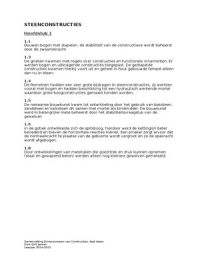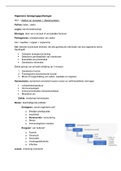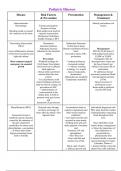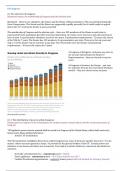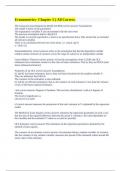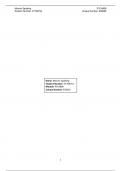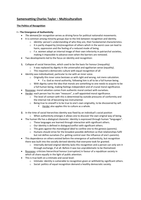Investment Analysis
MSc Finance
Tilburg University
Block 1
,Lecture 1
Essential nature of investment:
• Reduced current consumption
• Planned later consumption
Real assets: assets used to produce goods and services
Financial assets: claims on real assets
Consumption Timing – Example
• Two periods
• Each period I have income of $10,000
• Saving & borrowing possible at 5% interest rate
• Options
– Consume $10,000 in both periods
– Save everything now and consume in period 2. Save $10,000 at 5%, results in $10,500.
Consume $20,500 in period 2. Spend more in total due to investment
– Consume everything now. Consume $10,000 in period 1 + maximum amount I can
borrow at 5%: $9,524 ($9,524*1.05=$10,000). Consume $19,524 in period 1. Spend
less in total due to consumption now
How to choose among possible outcomes: In-
difference curves: represent the investors pref-
erence for income in the two periods. Every-
where along the curves, the investor is assumed
to be equally happy.
You want to pick the utility curve the furthest
away from the axes: the highest utility.
In the example, you will end up in point D, on
the second utility curve, since this is the utility
curve that touches the consumption line. (you
want to have utility curve that touches and does
not intersect the consumption line)
Portfolio: Collection of investment assets:
• Asset allocation: choose among broad asset classes
1
, • Security selection: choose securities within each asset class
Security analysis:
• Top-Down: asset allocation first, then pick securities (recommended)
• Bottom-Up: attractively priced securities, without much concern for asset allocation
Risk-return trade-off:
• Active management:
– Finding misprices securities
– Timing market
– Trading costs/management fees
• Passive management:
– Highly diversified portfolio
– Lower trading costs/management fee
Financial markets
• Money market: short-term, liquid, low-risk
– T-bills
– Certificates of deposits
– Commercial paper
– Bankers’ acceptance
– Eurodollars
– Repurchase agreements
– Federal funds
– Brokers’ calls
• Capital markets, longer term, more risky
– Bond market
* Treasury notes and bonds
* Corporate bonds
* Municipal bonds
2
, * Mortgage securities
* Federal agency debt
– Equity markets
* Common stock
* Preferred stock
– Derivative markets: derivative asset: a claim whose value is contingent on the value of
some underlying asset
* Options
* Futures
Firms can raise funds by borrowing money or by selling shares:
• Primary market : new issues of securities
• Secondary market: trading existing securities
Public offerings of stocks/bonds aremarketed by underwriters
Lecture 2
Vaak niet meteen de hoogste return in eerste jaren na IPO, duurt altijd even
Special purpose acquisition company (SPAC)is a shell company formed to raise capital through an
IPO in order to acquire an existing company
,→ have no existing business operations
Investors in SPAC: private equity firms/ general public
Money raised through IPO is placed in interest-bearing trust account
Money can only be spent on:
1. Acquisition within 2 years
2. if 1 not possible, return money to investors
Types of orders:
• Market- executed immediately
– Bid price
– Ask price
• Price-contingent
3
MSc Finance
Tilburg University
Block 1
,Lecture 1
Essential nature of investment:
• Reduced current consumption
• Planned later consumption
Real assets: assets used to produce goods and services
Financial assets: claims on real assets
Consumption Timing – Example
• Two periods
• Each period I have income of $10,000
• Saving & borrowing possible at 5% interest rate
• Options
– Consume $10,000 in both periods
– Save everything now and consume in period 2. Save $10,000 at 5%, results in $10,500.
Consume $20,500 in period 2. Spend more in total due to investment
– Consume everything now. Consume $10,000 in period 1 + maximum amount I can
borrow at 5%: $9,524 ($9,524*1.05=$10,000). Consume $19,524 in period 1. Spend
less in total due to consumption now
How to choose among possible outcomes: In-
difference curves: represent the investors pref-
erence for income in the two periods. Every-
where along the curves, the investor is assumed
to be equally happy.
You want to pick the utility curve the furthest
away from the axes: the highest utility.
In the example, you will end up in point D, on
the second utility curve, since this is the utility
curve that touches the consumption line. (you
want to have utility curve that touches and does
not intersect the consumption line)
Portfolio: Collection of investment assets:
• Asset allocation: choose among broad asset classes
1
, • Security selection: choose securities within each asset class
Security analysis:
• Top-Down: asset allocation first, then pick securities (recommended)
• Bottom-Up: attractively priced securities, without much concern for asset allocation
Risk-return trade-off:
• Active management:
– Finding misprices securities
– Timing market
– Trading costs/management fees
• Passive management:
– Highly diversified portfolio
– Lower trading costs/management fee
Financial markets
• Money market: short-term, liquid, low-risk
– T-bills
– Certificates of deposits
– Commercial paper
– Bankers’ acceptance
– Eurodollars
– Repurchase agreements
– Federal funds
– Brokers’ calls
• Capital markets, longer term, more risky
– Bond market
* Treasury notes and bonds
* Corporate bonds
* Municipal bonds
2
, * Mortgage securities
* Federal agency debt
– Equity markets
* Common stock
* Preferred stock
– Derivative markets: derivative asset: a claim whose value is contingent on the value of
some underlying asset
* Options
* Futures
Firms can raise funds by borrowing money or by selling shares:
• Primary market : new issues of securities
• Secondary market: trading existing securities
Public offerings of stocks/bonds aremarketed by underwriters
Lecture 2
Vaak niet meteen de hoogste return in eerste jaren na IPO, duurt altijd even
Special purpose acquisition company (SPAC)is a shell company formed to raise capital through an
IPO in order to acquire an existing company
,→ have no existing business operations
Investors in SPAC: private equity firms/ general public
Money raised through IPO is placed in interest-bearing trust account
Money can only be spent on:
1. Acquisition within 2 years
2. if 1 not possible, return money to investors
Types of orders:
• Market- executed immediately
– Bid price
– Ask price
• Price-contingent
3


